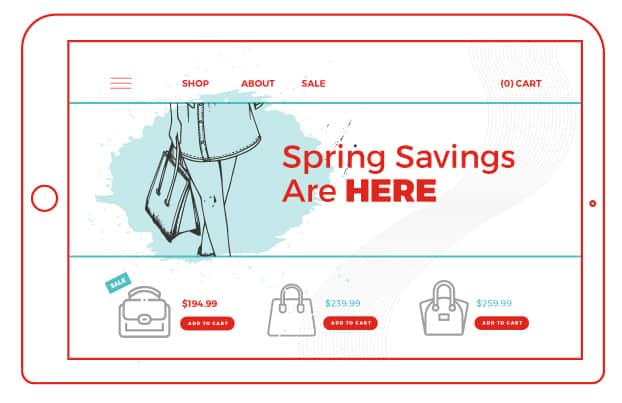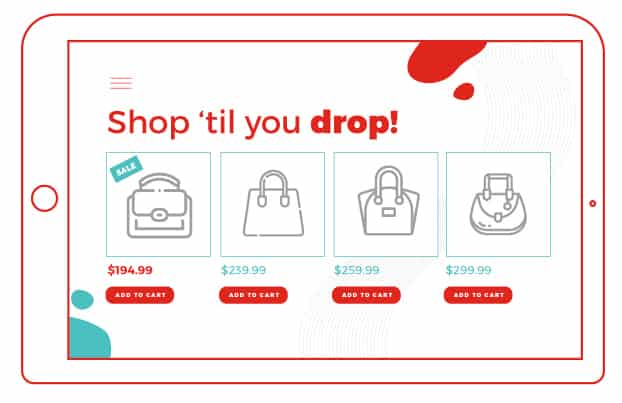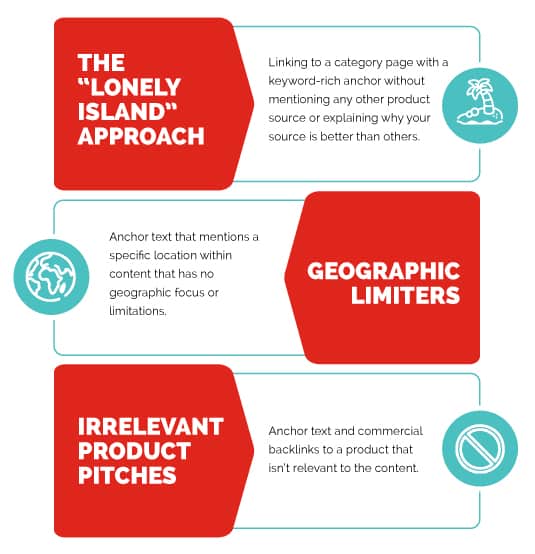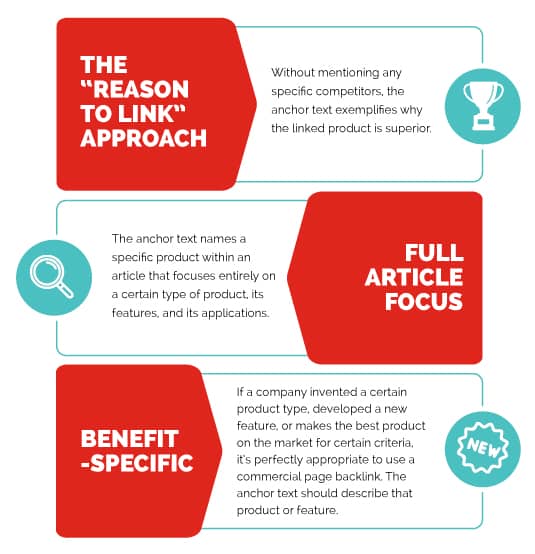Anyone who manages or contributes to an e-commerce website understands the ultimate objective: bringing in traffic and converting visitors to customers. Whether directly or indirectly, everything that site managers, digital marketers, designers, and writers do should serve the greater purpose of generating sales.
Of course, there are infinite marketing strategies and tactics that teams can employ to improve their domain’s rank and authority and, in turn, accomplish their business objectives. To name a few, e-commerce marketers can:

- Develop web and app platforms with high-quality UX and UI design
- Build out the website with useful content such as digital tools, industry information, and blog posts
- Run paid ad campaigns
- Generate buzz on social media
To meet sales and performance metrics each quarter, marketing teams need to create comprehensive strategies that cover all of these bases and more. When it comes to execution, one of the most critical yet often overlooked tactics for improving domain rank and authority is link building.
The Value of Link Building
Although Google’s algorithm has evolved over the years, it still uses backlinks as a key ranking signal. Google treats outbound links to independent websites as votes of confidence from the original referrer. If a company, organization, or individual leads readers away from their content with a link, it indicates the following:

- They trust the linked website and brand
- They recommend the linked or referenced products
- The linked page is relevant to their readers
- They believe the linked content adds value to their own
Google rewards backlinks when configuring page rank and authority. However, not all links are equal; Google gives more weight to backlinks from high-traffic, high-authority sites.
Link Building Strategy
Numerous factors should play into any brand’s link building strategy. Each of the following elements affects the value of backlinks or how natural they appear to readers:
- Backlink page and domain authority, rank, traffic, relevance, and content quality
- The search volume of the targeted keywords
- Individual anchor texts
- A site’s overall anchor text profile
- The relevancy and quality of the domain and landing page selected for each backlink
Each of these factors requires thought and planning, but many marketers and site managers overlook the importance of choosing the right landing pages for backlinks. No matter how much time and effort your team puts into creating content or securing mentions, it won’t increase sales very much if the linked pages aren’t carefully selected.
Choosing the Right Landing Pages

Whether creating guest posts for independent blogs, producing infographics and other competitive resources, or claiming unlinked brand mentions, content producers need to ensure that backlinks appear natural and match the expectations of readers.
Backlinks serve as funnels to a domain; you don’t want to waste any conversion opportunities by sending readers to pages that have little or nothing to do with the original content they were browsing.
In general, outbound links fall under two umbrella categories: commercial and non-commercial backlinks. Commercial links lead to direct avenues for making purchases, such as product pages. Non-commercial links, on the other hand, link to homepages or content-based pages such as blog posts and general informational pages.
Creating a comprehensive digital marketing strategy requires analyzing data to determine which landing pages have the highest conversion rates. Performance metrics will indicate which pages need improvement and which landing page types deserve more attention.
Based on the landing page selected, a backlink’s anchor text and the surrounding content should follow different guidelines. Keep reading to learn how to develop content and anchor text that’s best fit for links to homepages, category pages, and individual product pages.
Linking to Your Homepage

When to Link to Your Website’s Homepage
Generally speaking, links to website homepages don’t generate sales directly. Nonetheless, homepage backlinks are essential to digital marketing because they help build brand trust from Google, and they help establish general brand awareness.
Unlike commercial backlinks, homepage backlinks don’t try to convince viewers to make a purchase immediately. SEOs use homepage backlinks not to promote specific products, but rather to introduce the brand to people within their target audience and to offer them a cursory understanding of the company. The homepage can also be used for internally linking to other pages to increase their rankings.
Homepage Content and Design Strategy
Before devising strategies to bring visitors to your homepage, it’s important to review the purpose and objectives of website homepages. Homepages serve as the “face” of a brand. While they don’t have to provide every detail about the company they represent, they should signify to users what the business does or sells and what sets the brand apart from its competition. Homepages also have to engage visitors visually, have an intuitive design, and present clear calls to action.
Without these critical features, securing backlinks to a homepage won’t entice consumers or improve site performance metrics. Readers won’t perceive the value the link adds to the original content they were consuming.
The Right Content for Homepage Backlinks
Homepage backlinks fit naturally within two very different types of content. While they contract each other, both content forms play a role in any comprehensive link building strategy.
1. General Content with Wide Appeal
Instead of creating niche or hyper-focused content, write articles that cover a wide array of topics or that discuss trends, ideas, products, or services from a broad point of view. In other words, produce content that people within your target audience would read even if they didn’t have strong purchase intent for any specific product.
- Homepage backlinks fit most naturally in the following content forms: trend pieces, listicles, guides, and roundups.
- When it comes to anchor text, it’s important not to mislead readers. Within content with a broad focus, use branded anchor text to invite readers to your homepage.
2. Focused Content with Industry Appeal
Securing brand mentions is an essential aspect of any digital marketing strategy. Direct mentions from independent websites build brand trust with both Google and consumers. To improve SEO metrics and gain name recognition, create content that explicitly but naturally names your brand and uses your brand name as anchor text for a homepage backlink.
- To build content with brand mentions, focus on guest posting on industry-specific blogs and publications. Interviews, reviews, resource pages, trend pieces, and roundups make brand mentions appear natural.
Linking to Commercial Pages

What are Commercial Pages?
Commercial pages (also commonly referred to as “product pages” or “service pages”) directly sell products or services. While these pages may include additional information, they primarily serve as avenues for customers to purchase a product or register for services. Most commercial pages on e-commerce sites have some form of an “Add to Cart” button.
Why Link to Commercial Pages?
Apart from linking to any specific page for higher rankings, the purpose of linking to a commercial page is to drive sales or create leads directly. When a marketing team decides to push certain lines or products, commercial page backlinking is a great way to promote these specific products rather than the brand at large.
Think of commercial pages as explicit sales pitches. Keep that in mind when deciding whether or not to backlink to commercial content; you never want to surprise a reader with a product page.
Creating Content with Commercial Page Backlinks
As a general rule of thumb, it’s best only to include commercial page links within content that individuals with high purchase intent tend to read. For example, if someone is reading a listicle titled “Top 10 Cordless Vacuums,” it indicates that they’re researching to make a purchase. In this context, it’d be appropriate to send readers to a commercial page selling cordless vacuums.
Certain content forms naturally attract this audience and lend themselves to e-commerce backlinks. If your marketing team creates and distributes content, consider the following forms for any articles intended to have backlinks to commercial pages:
- Listicles and roundups
- Resource links
- Product reviews
- Articles about product applications
- Articles about a general product type
Product Pages vs. Category Pages
When creating content with links to commercial pages, you have to decide whether to send readers to a product category page or an individual product page. This decision should depend on two factors: the context of the backlink and your specific sales goals.
Category Pages– Not only do category pages help organize an e-commerce site, but they also help marketers optimize for broader keywords and match search intent. When it comes to backlinking, it allows SEOs and writers to create natural e-commerce links even within content that doesn’t discuss the exact products their brand sells.
For example, imagine a writer developing content for an e-commerce site that sells environmentally-friendly cleaning products. They want to write a guest post titled “5 Ways to Lower Your Carbon Footprint” for a general lifestyle blog. One of the five suggestions is to switch to eco-friendly cleaning products, but the other four have nothing to do with cleaning.
Most of the lifestyle blog’s readers won’t know the ins and outs of eco-friendly products. If a link within the article takes them to a product page for a specific baking soda cream cleaner, they’ll probably click away quickly because the page is too specific.
However, if the writer sends readers to a category page for all kitchen-safe, eco-friendly cleaners, they may browse around to learn more about the products and to find a specific type of cleaner they’re interested in.
Specific Product Pages– Backlinks to specific product pages, on the other hand, tend to perform best within more niche content.
For example, an article titled “7 Features to Look for in a Mountain Bike” would generally only attract individuals interested in making a mountain bike purchase at some point. This audience doesn’t want to read generalized content; they want to get into the nitty-gritty of mountain bike features, mechanics, and performance metrics.
If one of the seven features listed is hydraulic brakes, a reader wouldn’t be surprised if a link within that section took them to a product page for a specific bike with this feature. Conversely, if the hyperlink took them to a category page for all mountain bikes, they’d still have to search within the page for bikes with hydraulic brakes. Anything that adds more work for consumers deters sales.
When producing content with commercial backlinks, choosing the anchor text of the link is critical for SEO metrics and for establishing brand trust with readers. The anchor text of a backlink should signal to readers what waits on the other side of the link. If it doesn’t, visitors will leave the page, raising bounce rates.
Think of anchor text like labels on boxes. The label doesn’t have to describe with great detail what’s inside the box, but it should establish general expectations. When creating anchor text for commercial links, try to avoid the following mistakes:

The “Lonely Island” Approach– Linking to a category page with a keyword-rich anchor without mentioning any other product source or explaining why your source is better than others.
- Example: A writer for a paintbrush company creates a guest post with the article title “All the Supplies You Need to Start Painting” and discusses paper, brushes, palettes, and easels. If the article contains no other commercial links or specific product mentions, it wouldn’t make sense for the stand-alone anchor text “watercolor paintbrushes” to link to a product page.
Geographic Limiters– Anchor text that mentions a specific location within content that has no geographic focus or limitations.
-
-
- Example: In a general article about how to find professional graphic designers, the anchor text “best graphic designers in San Francisco” would not be appropriate.
-
Irrelevant Product Pitches– Anchor text and commercial backlinks to a product that isn’t relevant to the content.
-
-
-
- Example: Including the anchor text “multi-speed blender” and backlinking to a blender product page within an article about convection ovens.
-
-
Natural Anchor Text for Commercial Links
In order to create commercial links that feel natural, try the following anchor text strategies:
The “Reason to Link” Approach – Without mentioning any specific competitors, the anchor text exemplifies why the linked product is superior.

- Example: A content-creator for a makeup brand writes a guest post titled “Understanding Socially Conscious Makeup” for a beauty blog. The submitted article explains numerous ways that some cosmetic companies overlook human rights violations. A subsection of the article focuses on the negative social effects of the mica mining industry.
The writer could include the following sentence: “Some brands, however, only use synthetic mica to add sparkle to their highlighters” with a hyperlink to their website’s product category page for highlighters.
Full Article Focus – The anchor text names a specific product within an article that focuses entirely on a certain type of product, its features, and its applications.
-
- Example: A writer puts together an article that focuses on the uses of essential oils. A subsection could discuss lavender essential oils specifically and include the sentence, “Try a lavender essential oil to relieve stress and fall asleep faster.” The writer should link to a specific product page using the phrase “lavender essential oil” within that sentence as the anchor text.
Benefit-Specific – If a company invented a certain product type, developed a new feature or makes the best product on the market for certain criteria, it’s perfectly appropriate to use a commercial page backlink. The anchor text should describe that product or feature.
-
- Example: Within the smartphone market, companies compete to design the phone with the longest battery life. If a smartphone manufacturer can prove their claims, they could use the anchor text “the phone with the longest battery life” in their marketing content.
Linking Content and Landing Pages
Successful link building relies on anticipating the intent of web users, producing useful content, choosing relevant landing pages that solidify consumer trust, and creating outbound links that look natural.
Without all of the elements, backlinks backfire; without context, they confuse visitors, and without organic anchor text, they irritate readers. To improve SEO and build brand trust, marketers have to put the time and effort into creating quality content that draws readers to the right pages.



